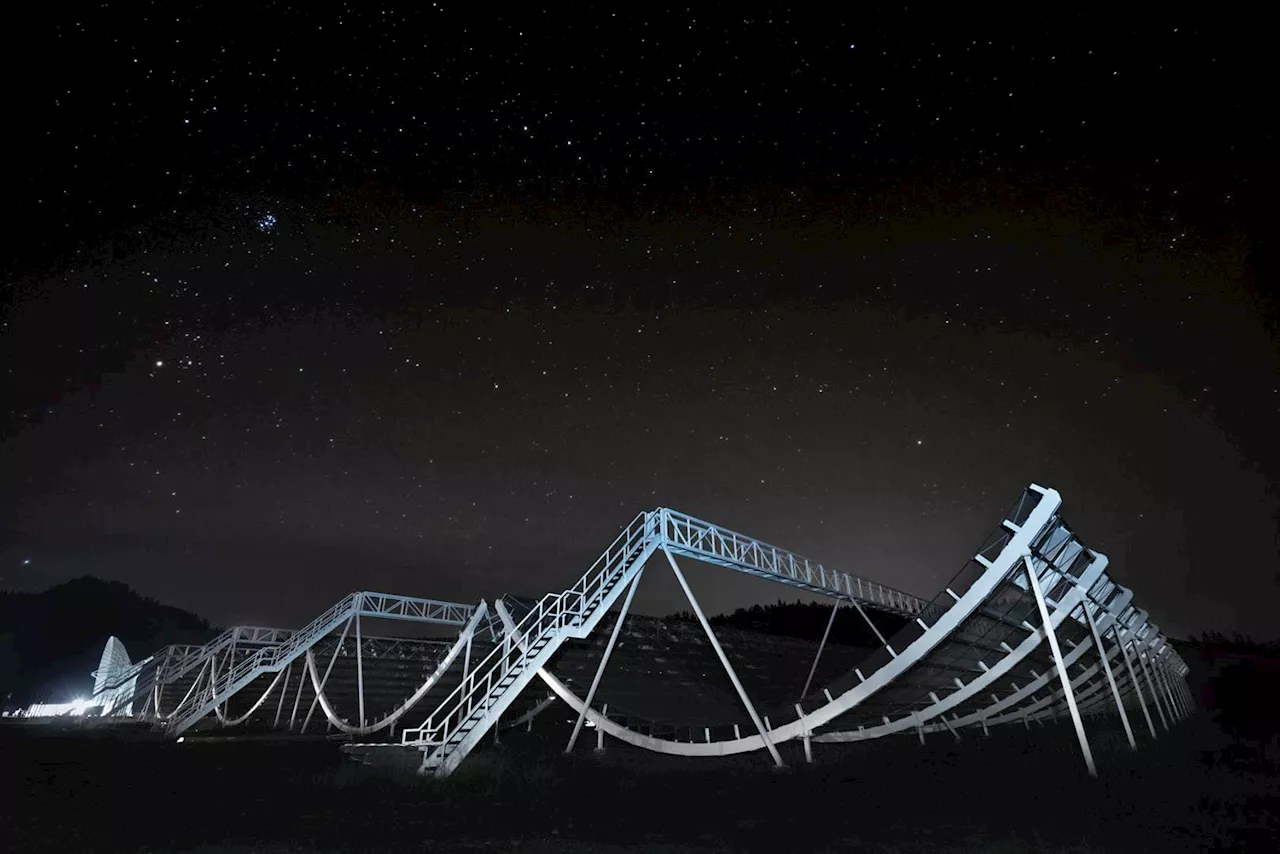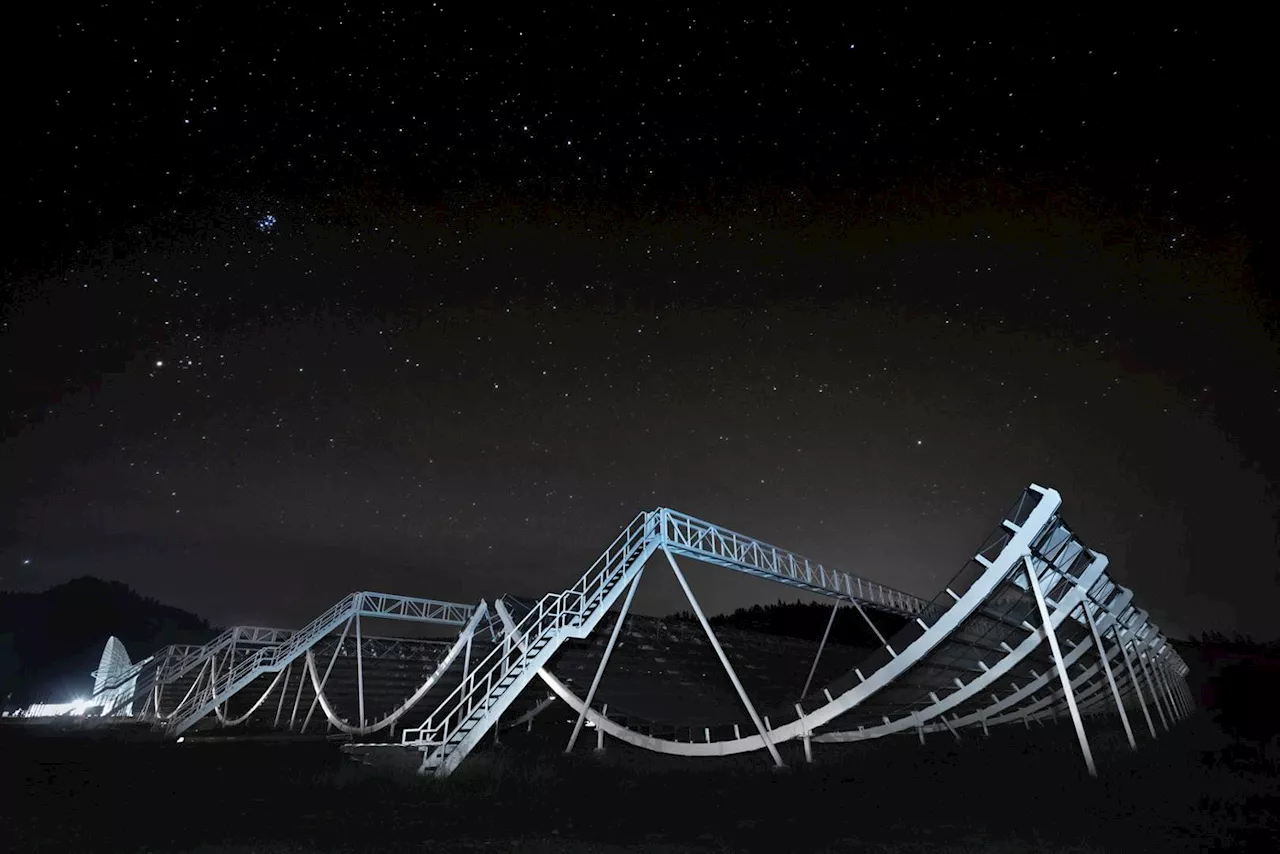Astronomers have detected a repeating fast radio burst (FRB) that originates from an unusually old galaxy, challenging the prevailing theory that FRBs are caused by young magnetars. The discovery, based on observations of FRB 20240209A by the CHIME radio telescope, suggests that FRBs may be produced by a wider range of astrophysical processes.
Fast radio bursts (FRBs) are intense flashes of radio light that last for only a fraction of a second. They are thought to be caused by the intense magnetic fields of a magnetar, which is a highly magnetic neutron star. Beyond that, FRBs remain a bit of a mystery. We know that most of them originate from outside our galaxy, though the few that have occurred within our galaxy have allowed us to pinpoint the source on neutron stars .
We also know that some of them repeat, meaning that FRBs can’t be caused by a cataclysmic event such as a supernova. Thanks to one repeating FRB, we now know something new about them. Astronomers looked at FRB 20240209A, which was first observed by the CHIME radio telescope in February 2024. The FRB happened to be a repeater and was observed 21 times between February and June. Because it kept repeating, the team was able to observe six of the FRB events from a smaller, companion observatory 60 kilometers away. This allowed the team to pinpoint the source even though it was two billion light-years away. They found a couple of unusual things. First, the FRB originated from the edge region of a galaxy. Most FRBs occur in the more central region of a galaxy because that’s where stars form and therefore where you’re more likely to find neutron stars. The second was that this particular galaxy is more than 11 billion years old, and is well past its star-forming period. What’s surprising about that is that neutron stars are the remnants of massive stars that die as supernovae. Large stars have cosmically short lifetimes, so the fact that this FRB occurred in an old, long-dead galaxy means that the neutron star that generated it must also be old. The general reasoning was that FRBs are caused by young magnetars. The thought is that they could be caused by magnetic flares, similar to solar flares of the Sun. But since neutron stars can’t generate new heat, they cool and become inactive over time. So we shouldn’t see old neutron stars generating FRBs. This study proves that old stars can create FRBs. One explanation for this is that the FRB might have occurred not within the galactic edge itself, but rather in a dense globular cluster orbiting at the edge of the galaxy. The galaxy is too far away for us to distinguish between these two options, but globular clusters are known to have numerous stellar mergers. One possibility is that this repeating FRB was caused by merging magnetars. As their magnetic fields merged and realigned, bursts of radio energy were released to create the FRB. It will take more observations to be sure, but it is now clear that the astrophysical processes that create FRBs are more diverse than we thought
Fast Radio Bursts FRB 20240209A Magnetars Neutron Stars Galaxy Evolution
United States Latest News, United States Headlines
Similar News:You can also read news stories similar to this one that we have collected from other news sources.
 Old Stars Surprise Scientists by Generating Fast Radio BurstsA repeating fast radio burst (FRB) originating from an ancient galaxy has challenged conventional understanding of these enigmatic phenomena. Analysis of FRB 20240209A, observed by the CHIME radio telescope, revealed that the source lay at the edge of a galaxy older than 11 billion years, significantly exceeding the typical age of FRB-producing neutron stars. This discovery suggests the possibility of alternative mechanisms for generating FRBs, potentially involving merging magnetars within globular clusters orbiting these old galaxies.
Old Stars Surprise Scientists by Generating Fast Radio BurstsA repeating fast radio burst (FRB) originating from an ancient galaxy has challenged conventional understanding of these enigmatic phenomena. Analysis of FRB 20240209A, observed by the CHIME radio telescope, revealed that the source lay at the edge of a galaxy older than 11 billion years, significantly exceeding the typical age of FRB-producing neutron stars. This discovery suggests the possibility of alternative mechanisms for generating FRBs, potentially involving merging magnetars within globular clusters orbiting these old galaxies.
Read more »
 Magnetar's Magnetic Fields Detected as Source of Fast Radio BurstAstronomers have traced a fast radio burst (FRB) detected in 2022 to a magnetar, a type of neutron star with extremely powerful magnetic fields, located in a galaxy 200 million light-years away. This provides the first conclusive evidence that FRBs can originate from the magnetospheres of magnetars. FRBs are brief, powerful bursts of radio emission that are difficult to study due to their unpredictable nature and fleeting duration.
Magnetar's Magnetic Fields Detected as Source of Fast Radio BurstAstronomers have traced a fast radio burst (FRB) detected in 2022 to a magnetar, a type of neutron star with extremely powerful magnetic fields, located in a galaxy 200 million light-years away. This provides the first conclusive evidence that FRBs can originate from the magnetospheres of magnetars. FRBs are brief, powerful bursts of radio emission that are difficult to study due to their unpredictable nature and fleeting duration.
Read more »
 FRB 20221022A: A Fast Radio Burst Originating from a Neutron Star's MagnetosphereA team of astronomers at MIT has detected an FRB (Fast Radio Burst) originating from a region incredibly close to a rotating neutron star. This discovery sheds light on the origins of FRBs and suggests they can be produced within the neutron star's powerful magnetosphere.
FRB 20221022A: A Fast Radio Burst Originating from a Neutron Star's MagnetosphereA team of astronomers at MIT has detected an FRB (Fast Radio Burst) originating from a region incredibly close to a rotating neutron star. This discovery sheds light on the origins of FRBs and suggests they can be produced within the neutron star's powerful magnetosphere.
Read more »
 Ancient Galaxy Hosts Unexpected Fast Radio BurstA new fast radio burst (FRB) has been traced to the outskirts of an 11.3-billion-year-old galaxy, challenging the prevailing theory that these events originate solely from regions of active star formation. This discovery suggests that the origins of FRBs might be more diverse than previously thought.
Ancient Galaxy Hosts Unexpected Fast Radio BurstA new fast radio burst (FRB) has been traced to the outskirts of an 11.3-billion-year-old galaxy, challenging the prevailing theory that these events originate solely from regions of active star formation. This discovery suggests that the origins of FRBs might be more diverse than previously thought.
Read more »
 Challenging the Paradigm: A Distant FRB Questions Magnetar OriginsA recent fast radio burst detected at a vast distance throws doubt on the prevailing theory that magnetars, formed from the explosions of young massive stars, are the sole source of these enigmatic cosmic events.
Challenging the Paradigm: A Distant FRB Questions Magnetar OriginsA recent fast radio burst detected at a vast distance throws doubt on the prevailing theory that magnetars, formed from the explosions of young massive stars, are the sole source of these enigmatic cosmic events.
Read more »
 Pregnant Woman's Cough Leads to Shocking Medical DiscoveryMaKenna Lauterbach, 26, experienced severe coughing fits in the last three months of her pregnancy. Doctors initially dismissed her symptoms, attributing them to pregnancy. However, when the coughing led to vomiting, scans revealed a grapefruit-sized tumor in her chest cavity and right lung, blocking the artery to the right lung. The tumor, extremely rare in its invasion of major heart blood vessels, put Lauterbach and her baby in respiratory distress. She was airlifted to Northwestern Memorial Hospital in Chicago for emergency treatment.
Pregnant Woman's Cough Leads to Shocking Medical DiscoveryMaKenna Lauterbach, 26, experienced severe coughing fits in the last three months of her pregnancy. Doctors initially dismissed her symptoms, attributing them to pregnancy. However, when the coughing led to vomiting, scans revealed a grapefruit-sized tumor in her chest cavity and right lung, blocking the artery to the right lung. The tumor, extremely rare in its invasion of major heart blood vessels, put Lauterbach and her baby in respiratory distress. She was airlifted to Northwestern Memorial Hospital in Chicago for emergency treatment.
Read more »
